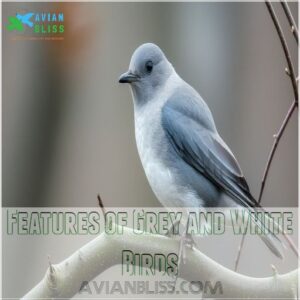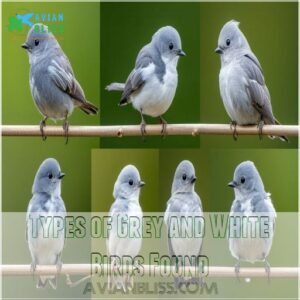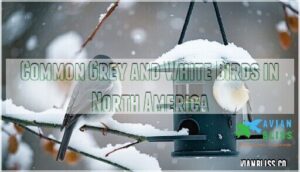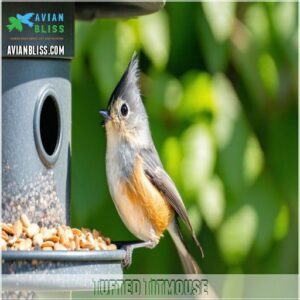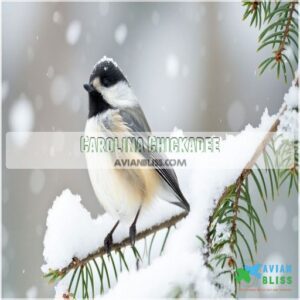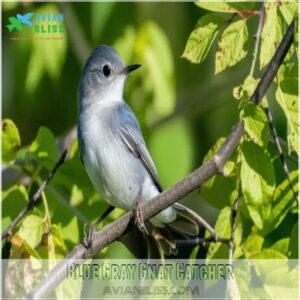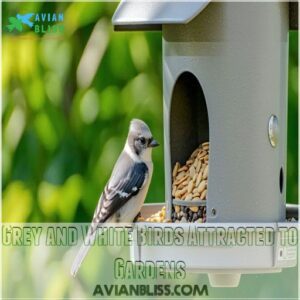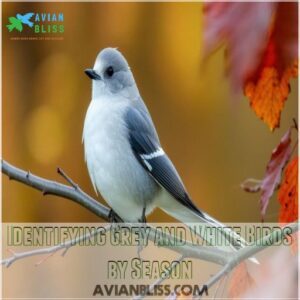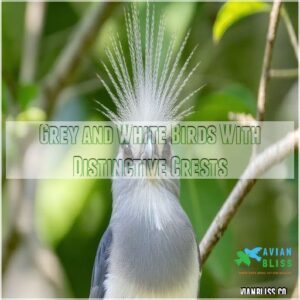This site is supported by our readers. We may earn a commission, at no cost to you, if you purchase through links.
1
These birds showcase stunning plumage patterns that help them blend into their surroundings, whether they’re soaring through city skies or foraging in suburban gardens.
Some species, like the tufted titmouse, sport distinctive crests, while others, like the dark-eyed junco, feature crisp contrasts between their grey backs and white bellies.
Each species has evolved unique behaviors and adaptations that make them fascinating to observe.
Their complex social structures and remarkable survival strategies reveal nature’s intelligent design at work.
Table Of Contents
- Key Takeaways
- Features of Grey and White Birds
- Types of Grey and White Birds Found
- Common Grey and White Birds in North America
- Grey and White Birds Attracted to Gardens
- Identifying Grey and White Birds by Season
- Grey and White Birds With Distinctive Crests
- Grey and White Birds With Black Markings
- Conservation Status of Grey and White Birds
- How to Create a Grey and White Bird-Friendly Yard
- Interesting Behaviors of Grey and White Birds
- Frequently Asked Questions (FAQs)
- What is a small gray bird?
- What are grey and white birds?
- What are the different types of gray birds?
- Are gray birds migratory?
- What is 48 birds of gray?
- What does a gray bird look like?
- Do grey and white birds mate with other colors?
- Whats the average lifespan of grey and white birds?
- Can grey birds change color during molting season?
- Where do grey birds migrate during extreme weather?
- How do grey birds communicate with different species?
- Conclusion
Key Takeaways
- You’ll find gray and white birds across North America, with species like the Dark-eyed Junco, Tufted Titmouse, and Carolina Chickadee each displaying unique behaviors and plumage patterns.
- You can attract these birds to your yard by providing diverse food sources, installing water features, and planting native trees and shrubs that offer shelter and nesting sites.
- Each species has evolved specific adaptations – from the Tufted Titmouse’s seed-cracking abilities to the Blue-gray Gnatcatcher’s acrobatic insect hunting techniques.
- You’ll need to protect these birds from habitat loss and chemical exposure by supporting conservation efforts and maintaining bird-friendly spaces in your backyard.
Features of Grey and White Birds
You’ll discover that grey and white birds stand out with their unique markings, from the distinctive black crest of the Tufted Titmouse to the mottled patterns of the Sandhill Crane.
Whether you’re watching a Dark-eyed Junco hop along your garden path or spotting an Eastern Phoebe perched near water, you’ll notice these birds combine elegant colors with remarkable adaptations for their specific habitats.
Grey and White Plumage Patterns
Every grey and white bird species has evolved unique plumage patterns that serve as their natural camouflage.
You’ll notice these patterns vary by region and season, helping birds blend into their surroundings.
From the soft, mottled greys of the Tufted Titmouse to the crisp white belly of the Dark-eyed Junco, these adaptations aren’t just beautiful – they’re essential survival tools shaped by millions of years of evolution.
Distinctive Song and Call Patterns
Beyond their striking appearance, grey and white birds command attention through their distinct vocal repertoire.
You’ll hear the Dark-eyed Junco’s gentle trill, while the Tufted Titmouse broadcasts its clear "peter-peter-peter" call across the forest.
The Carolina Chickadee adds its cheerful "chick-a-dee-dee" chorus, and the Northern Mockingbird might surprise you by mimicking the entire neighborhood’s worth of bird songs.
Unique Habitat and Foraging Behaviors
Just as these birds showcase unique calls, their habitats and feeding habits tell fascinating stories.
You’ll find grey and white birds thriving in diverse environments, from Dark-eyed Juncos scratching through forest floors to Eastern Phoebes catching insects mid-flight near streams.
Each species has carved out its own niche, whether it’s the Tufted Titmouse expertly cracking seeds or Carolina Chickadees gleaning insects from tree bark.
Types of Grey and White Birds Found
The realm of grey and white birds holds a remarkable variety of species, each displaying its own unique charm and character, including the Grey Catbird with its charcoal grey body and black cap.
From coastal wanderers to mountain dwellers, these feathered friends come in all shapes and sizes.
You’ll find them adapting to diverse environments across the globe:
- Seabirds like gulls and terns, masters of coastal living with their streamlined bodies
- Mountain specialists such as snow buntings, perfectly camouflaged for alpine environments
- Urban adaptors like pigeons and doves, making their homes alongside humans
Let’s explore how these grey and white birds have evolved to thrive in their specific habitats.
Common Grey and White Birds in North America
You’ll find a remarkable variety of grey and white birds across North America’s diverse landscapes, from the nimble Dark-eyed Junco to the vocal Tufted Titmouse.
These distinctive birds share similar coloring but display unique behaviors and patterns that make them fascinating to observe in your backyard or local park.
Dark-eyed Junco
Dark-eyed Juncos are a common winter visitor to Massachusetts backyards, often arriving with a splash of color to the winter landscape as part of the seasonal changes in backyard birds of Massachusetts. Dark-eyed Juncos’ distinctive gray and white plumage makes them a winter delight at backyard feeders.
You’ll likely catch these birds in Virginia’s native habitats, such as lush forests and urban parks, where they thrive amidst the state’s diverse range of bird species. You’ll spot these small songbirds hopping around your garden, their white bellies flashing as they forage for seeds.
Their migration patterns bring them south during colder months, while summer finds them nesting in northern forests.
Listen for their soft trills and metallic chips, which sound like tiny bells in the morning air.
Tufted Titmouse
Unlike their ground-dwelling cousins, Tufted Titmice light up your backyard with their distinctive black crests and curious personalities.
You’ll spot these vocal acrobats sporting white breasts and orange-brown flanks as they dart between feeders.
At 5.5-6.3 inches long, they’re masters of winter survival, stashing sunflower seeds in tree bark for later snacks.
Their "peter-peter-peter" calls echo through deciduous woods year-round.
Carolina Chickadee
Small but mighty, Carolina Chickadees bring cheerful energy to your backyard with their distinctive "chick-a-dee-dee" calls. You’ll spot these agile acrobats by their white chest, orange-brown flanks, and gray back.
They’re incredible memory champions, remembering thousands of food cache locations throughout winter.
- They can remember up to 1,000 hidden seed locations for weeks
- Their complex calls warn other birds about predator size and threat level
- They form mixed-species flocks in winter for better survival chances
Blue Gray Gnat Catcher
A swift shadow flits through the treetops – that’s your Blue Gray Gnat Catcher in action! You’ll spot these tiny hunters by their bluish-gray upper parts and crisp white underparts.
Here’s what makes these insect-eating specialists truly fascinating:
| Feature | Function | Fun Fact |
|---|---|---|
| Long antennae | Prey detection | Can sense insects from 3 feet away |
| Large eyes | Hunting accuracy | Spots prey in dim light |
| Agile flight | Chase capture | Makes 180° turns mid-flight |
| Thin beak | Precise grabbing | Plucks insects off leaves |
| Vocal range | Territory defense | Mimics other birds’ calls |
Grey and White Birds Attracted to Gardens
You’ll find that grey and white birds like the tufted titmouse and dark-eyed junco become regular visitors once you’ve set up the right mix of feeders, water sources, and native plants in your garden.
With a combination of sunflower seeds, berry-producing shrubs, and fresh water features, you’re creating an irresistible habitat that these striking birds will return to throughout the year.
Food Preferences for Grey and White Birds
Ever wondered what’s on the menu for our feathered grey and white friends?
These birds have diverse appetites: seed-eating species like Dark-eyed Juncos love sunflower seeds and millet, while insect-catching birds such as Eastern Phoebes snap up flying insects.
You’ll find Tufted Titmice raiding backyard feeders for nuts, and Blue Gray Gnatcatchers expertly plucking tiny insects from tree branches.
Native Plants for Shelter and Nesting
Native plants serve as natural sanctuaries for our feathered friends, providing both shelter and nesting spots.
Here are the top native plants that’ll transform your garden into a bird paradise, much like the ones attracting year-round residents like House Finches and Black-capped Chickadees to colorado backyard birds. Here are the top native plants that’ll transform your garden into a bird paradise:
- Oak trees offer sturdy branches for nest building
- Dense evergreen shrubs create safe hideaways from predators
- Berry-producing bushes provide food and coverage
- Tall grasses supply perfect nesting materials
- Flowering perennials attract insects for protein-rich meals
Plant these natives strategically near birdhouses for maximum effectiveness.
Water Sources for Drinking and Bathing
Birds need clean water for both drinking and splashing around.
You’ll get the most visitors by offering water at different heights and depths.
Set up a shallow birdbath (1-2 inches deep) at ground level, and add a hanging bath or fountain for variety.
Moving water, like a small pump or dripper, works like a magnet – attracting even the shyest grey and white species to your yard.
Identifying Grey and White Birds by Season
You’ll find that grey and white birds display distinct seasonal behaviors that make identification easier throughout the year.
Each bird species has unique feeding patterns that influence their foraging behaviors and survival strategies understanding bird behavior feeding patterns. Each season brings unique migration patterns, breeding habits, and foraging behaviors that you can use to recognize these beautiful birds in your area.
Spring Migration Patterns
Spring brings a remarkable show as grey and white birds paint the skies on their migration routes.
You’ll spot Dark-eyed Juncos heading north from your feeders, while Tufted Titmice establish their territories.
Modern tracking technology reveals these birds navigate using Earth’s magnetic field and stars.
Keep your eyes peeled for Eastern Phoebes, arriving early to catch the first insects of the season.
Summer Breeding and Nesting Habits
As summer’s warmth blankets the landscape, our grey and white feathered friends settle into their breeding routines.
You’ll notice these remarkable behaviors in your backyard:
- Dark-eyed Juncos carefully weaving grass and twigs into cup-shaped nests
- Tufted Titmice claiming tree cavities with moss-lined nooks
- Carolina Chickadees raising 6-8 chicks in snug woodpecker holes
- Eastern Phoebes constructing mud-based homes under eaves and bridges
Keep your distance to help guarantee successful broods!
Fall Migration Patterns
The cool autumn breeze signals gray and white birds to begin their southward journey, as they instinctively follow ancient bird migration patterns driven by food sources.
You’ll spot Dark-eyed Juncos forming flocks, while Tufted Titmice prepare for local movements.
Watch for Eastern Phoebes following traditional migration routes along waterways, and Carolina Chickadees gathering in mixed-species groups.
These fall travelers face challenges like storms and habitat loss, making your backyard sanctuary an important stopover point.
Winter Foraging and Roosting Behaviors
Winter brings unique challenges for our feathered friends as they adapt their foraging and roosting habits. You’ll spot grey and white birds clustering near reliable food sources, often visiting backyard feeders more frequently than in warmer months.
- Dark-eyed Juncos huddle together in dense evergreen branches, sharing warmth
- Blue Gray Gnatcatchers conserve energy by entering short-term torpor overnight
Grey and White Birds With Distinctive Crests
You’ll find that distinctive crests set some grey and white birds apart from their plain-headed cousins, with species like the tufted titmouse displaying a striking pointed crown that serves as both a status symbol and a tool for communication.
These remarkable head features help you spot these birds more easily in your backyard or local park, where they’re often seen darting between feeders and tree branches.
Rock Pigeon
Many rock pigeons have mastered urban living, adapting from their cliff-dwelling ancestors to thrive in city environments.
You’ll spot these familiar grey birds perched on building ledges, which they use like their natural rocky habitat.
They’re surprisingly diverse in coloration, though most display a mix of grey and white feathers with iridescent neck patches.
When searching for food, they’ll waddle along streets and parks, picking up seeds and scraps.
Their nesting habits mirror their ancient roots – they’ll construct simple platform nests on any elevated, flat surface that reminds them of cliff ledges.
Northern Mockingbird
Unlike our city-dwelling Rock Pigeons, Northern Mockingbirds bring musical flair to your backyard with their impressive mimicry skills.
You’ll spot these medium-sized grey birds performing their greatest hits from dawn till dusk, copying everything from car alarms to other birds’ songs.
To entice these songbirds to your yard, consider using a Mockingbird attractant.
Their distinctive white wing patches flash during territorial displays, while their long tail dips and raises dramatically.
They’ve adapted brilliantly to urban environments, nesting in dense shrubs and defending their territory year-round.
Look for them perched prominently on fences or TV antennas, ready to showcase their vocal range.
Grey and White Birds With Black Markings
You’ll find that grey and white birds with black markings are among nature’s most striking artists, wearing their distinctive patterns like natural tuxedos.
These elegant birds, including the Black-capped Chickadee, Black-throated Gray Warbler, and Loggerhead Shrike, combine subtle grey tones with crisp black accents that make them easy to spot in your backyard or local woods.
Black-capped Chickadee
The Black-capped Chickadee‘s bold personality makes it a standout among crested birds.
You’ll spot these charismatic birds by their black cap, white cheeks, and gray wings. They’re master acrobats, often hanging upside down to snatch seeds and insects, utilizing their black and white patterns for camouflage and communication.
- Their "chick-a-dee-dee-dee" call warns other birds of danger
- They can remember thousands of food storage locations
- Their brain grows 30% larger in winter for better memory
- They form lifelong pairs, staying loyal through all seasons
Black-throated Gray Warbler
You’ll spot Black-throated Gray Warblers flitting through western forests, their striking black-and-white pattern making them a favorite among birdwatchers.
During migration, they journey from Mexico to Canada, feasting on insects they snatch from tree branches.
Listen for their distinctive buzzy "weeta weeta weet" song, especially during nesting season when males defend their territories in dense coniferous and mixed woodlands.
Loggerhead Shrike
Masked hunters of the skies, Loggerhead Shrikes stand out with their light gray bodies and distinctive black eye masks.
They’ve earned the nickname "butcher birds" for their unique hunting style – impaling prey on thorns or barbed wire.
To attract these birds, consider installing a Loggerhead Shrike Birdhouse.
While not currently threatened, their populations face challenges from habitat loss and pesticide use.
You’ll often spot these fascinating birds perched on fence posts, scanning for their next meal.
Conservation Status of Grey and White Birds
You’ll find that many grey and white bird species like the Snowy Plover and Yellow-billed Cuckoo face significant challenges from habitat loss and human development.
While some populations remain stable, you can help protect these birds by supporting conservation efforts and creating bird-friendly spaces in your backyard.
Threats to Grey and White Bird Populations
From habitat loss to climate change, our feathered friends face mounting challenges in their fight for survival.
Pesticide use continues to poison their food sources, while invasive species compete for nesting sites and resources.
Introduced species disrupt ecosystems, pushing many bird species closer to extinction, as seen in bird conservation efforts today.
Disease outbreaks, particularly avian flu, have devastated populations of grey birds like juncos and titmice.
Urban development fragments their habitats, making it harder for these beautiful creatures to thrive in our changing world.
Protected Areas for Grey and White Birds
Protected areas serve as sanctuaries for our feathered friends, keeping them safe from habitat loss and human disturbance.
These designated spaces offer essential refuge for numerous grey and white bird species across North America.
- National Wildlife Refuges maintain critical nesting grounds for Snowy Plovers
- State Parks protect essential stopover points for migrating Dark-eyed Juncos
- Local Conservation Areas preserve wetlands where American Dippers thrive
With proper management, these protected spaces help maintain healthy bird populations.
Efforts to Conserve Grey and White Bird Habitats
Conservation efforts for grey and white bird habitats have gained momentum through partnerships between wildlife organizations and local communities.
Habitat restoration projects focusing on protecting nesting grounds and migration corridors are underway.
Sustainable land management practices help maintain critical ecosystems, while citizen science initiatives track population changes.
Climate change impacts are being addressed through adaptive management strategies that preserve these birds’ essential environments.
How to Create a Grey and White Bird-Friendly Yard
You’ll discover how native plants, strategic feeding stations, and chemical-free practices can transform your yard into a haven for grey and white birds like juncos, titmice, and chickadees.
By following these proven habitat enhancement techniques, you’ll create an environment that provides essential food, shelter, and nesting sites for these remarkable species throughout the year.
Planting Native Trees and Shrubs
Native plants are like a five-star hotel for our feathered friends.
By incorporating native plants and creating a bird-friendly habitat that provides essential food sources, your backyard can become a bustling bird sanctuary when you choose the right trees and shrubs.
Here’s what local plants offer birds:
- Natural nesting materials and safe hideaways from predators
- Year-round shelter from harsh weather conditions
- Perfect perches for territorial displays and singing
- Sustainable insect populations for natural foraging
- Native berries and seeds that align with migration patterns
Providing Food and Water Sources
Setting up a buffet for your feathered friends isn’t rocket science.
You’ll want a variety of DIY feeders filled with sunflower seeds, mixed seeds, and suet to attract different gray and white species.
As for water, install multiple bird bath types at varying heights – from ground level to elevated platforms.
Keep water fresh and moving with a small fountain or dripper to make it irresistible.
Minimizing Chemical Use
While you’ve set up feeders and water sources, keeping your yard chemical-free makes it truly bird-friendly.
You’ll want to skip harsh pesticides and herbicides that can harm birds directly or kill off their natural food sources.
Instead, try companion planting or introducing beneficial insects for pest control.
Your feathered friends will thank you with their increased presence and healthier populations.
Interesting Behaviors of Grey and White Birds
You’ll discover how grey and white birds use complex social networks to communicate about food sources and potential threats in their environment.
From the Loggerhead Shrike’s habit of impaling prey on thorns to the American Dipper’s unique underwater feeding strategy, these birds show remarkable adaptations that help them thrive in diverse habitats.
Complex Social Behaviors
Many grey and white birds showcase fascinating social dynamics.
You’ll notice Dark-eyed Juncos forming tight-knit winter flocks, while Tufted Titmice establish hierarchical family groups.
During breeding season, Carolina Chickadees defend their territory through complex vocalizations.
Watch for Eastern Phoebes’ elaborate courtship displays, where males perform aerial acrobatics to impress potential mates.
These behaviors help support species survival through cooperation and communication.
Unique Foraging Strategies
Grey and white birds showcase fascinating foraging techniques that’ll make you look twice. From the Eastern Phoebe’s acrobatic aerial maneuvers to catch insects mid-flight, to the Loggerhead Shrike’s unique habit of impaling prey, each species has its own style.
The grey birds with yellow bellies, such as the Western Kingbird, also display unique behaviors, like agile foraging tactics.
- Dark-eyed Juncos hop forward-backward to uncover hidden seeds
- Tufted Titmice crack seeds by holding them with their feet
- Carolina Chickadees hang upside down to reach insects
- Blue Gray Gnatcatchers snatch tiny prey from spider webs
- Snowy Plovers perform foot-trembling to draw out buried prey
Adaptations for Survival in Various Habitats
Beyond their unique foraging methods, these remarkable birds have developed incredible adaptations for survival.
You’ll find Dark-eyed Juncos using camouflage to blend with winter snow, while Tufted Titmice master complex nesting strategies in tree cavities.
Eastern Phoebes showcase impressive predator avoidance by building nests under bridges and eaves, and Carolina Chickadees adjust their foraging patterns with seasonal changes to maximize food availability.
Frequently Asked Questions (FAQs)
What is a small gray bird?
Like tiny aerial acrobats, small gray birds such as the Dark-eyed Junco or Tufted Titmouse catch your eye with their sleek plumage.
Birds ranging from 12-18cm long and weighing just 20-30 grams.
What are grey and white birds?
You’ll spot several species with striking grey and white plumage, including the Dark-eyed Junco with its pink bill, and the Tufted Titmouse showing off its black crest and orange-brown flanks.
What are the different types of gray birds?
Common gray birds include the Dark-eyed Junco, Tufted Titmouse, Carolina Chickadee, Eastern Phoebe, and Blue Gray Gnat Catcher. Each species displays unique characteristics in their plumage, behavior, and habitat preferences.
Are gray birds migratory?
While some gray birds set off on epic migrations, others stay put year-round.
You’ll find Dark-eyed Juncos heading south for winter, while Tufted Titmice and Carolina Chickadees prefer to brave the cold at home.
What is 48 birds of gray?
There isn’t a specific "48 birds of gray" classification in ornithology. You’re probably thinking of different gray bird species, such as the Carolina Chickadee with its distinctive black cap and white cheeks, often found in common birds in virginia, that can be found across North America, including juncos, titmice, and phoebes.
What does a gray bird look like?
Beauty’s in the feathers they say.
Gray birds sporting shades from slate to silver, with distinctive features like crests, wing bars, or white bellies.
They’re often medium-sized with short, stout bills.
Do grey and white birds mate with other colors?
Birds can mate with different colored partners within their species, but they won’t crossbreed with other species.
Behavior and health are the typical factors that grey and white feathered friends consider when choosing mates, not color.
Whats the average lifespan of grey and white birds?
Most gray and white songbirds live 2-5 years in the wild, though you’ll find some species like the Snowy Plover reaching 15 years.
Larger birds like Canada Geese can survive 20-25 years.
Can grey birds change color during molting season?
Like a wardrobe refresh, grey birds undergo dramatic color changes during molting.
You’ll notice their feathers can shift to richer greys, browns, or even develop iridescent sheens as they replace old plumage with new.
Where do grey birds migrate during extreme weather?
During harsh weather, you’ll find these feathered friends heading south, where they’ll seek warmer temperatures and abundant food sources in coastal regions, wetlands, or dense forests below the frost line.
How do grey birds communicate with different species?
Gray birds communicate through diverse vocalizations, from warning calls to mating songs.
Body language is also used by these birds, including bobbing heads and fluttering wings to interact with different species in their habitat.
Conclusion
While spotting grey and white birds might seem challenging at first, you’ll soon discover these elegant creatures are all around us.
From your backyard feeders to local parks, these adaptable birds showcase nature’s finest designs.
Whether you’re watching a tufted titmouse gather seeds or a mockingbird defend its territory, each species tells a unique story.
By creating welcoming habitats and learning their behaviors, you’ll join countless enthusiasts who’ve discovered the joy of observing these remarkable grey and white birds.

